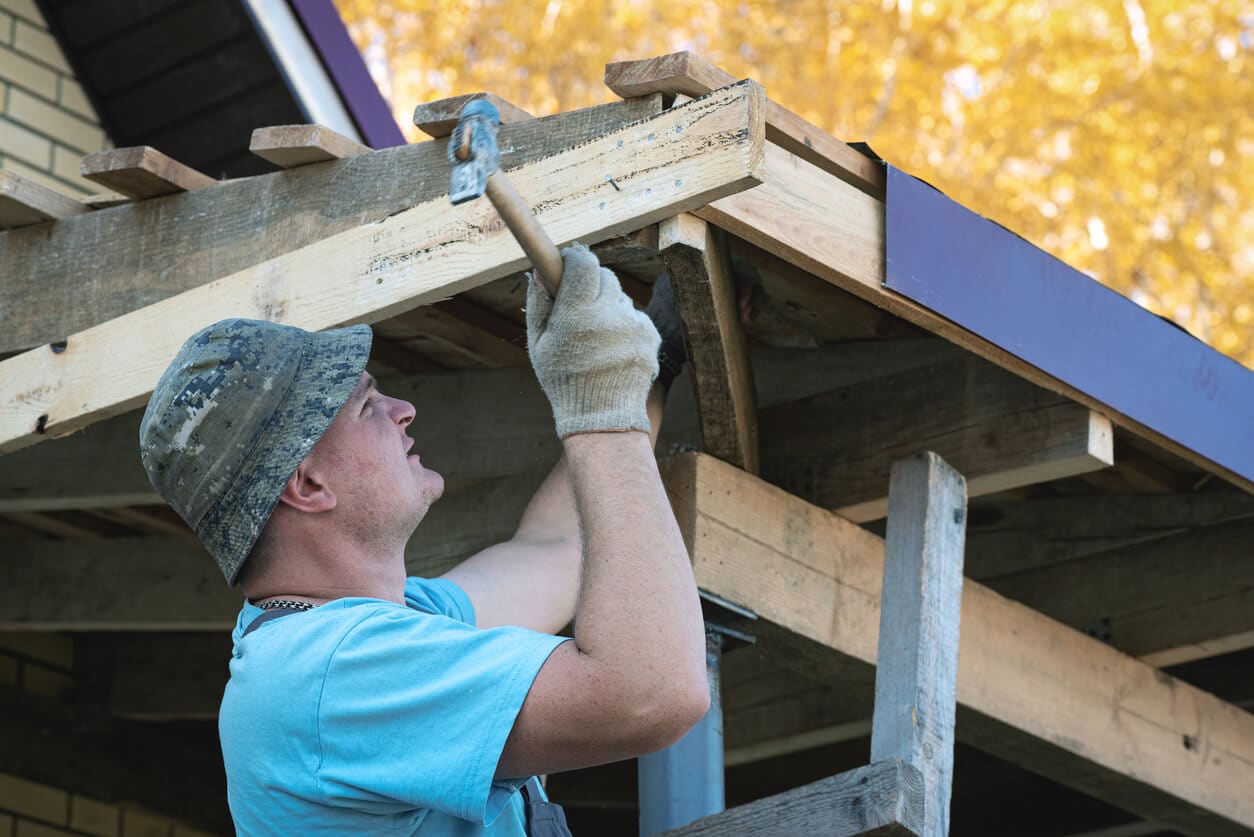
When your roofline starts to show signs of wear, it’s often the soffit and fascia that are quietly signaling a bigger issue. These two components play a vital role in protecting your home from water damage, pests, and structural decay.
Yet, many homeowners overlook them until there’s visible rot, peeling paint, or sagging gutters. Timely soffit and fascia repair isn’t just about appearances; it’s key to maintaining the integrity of your entire roofing system.
Whether you’re noticing the first signs of trouble or comparing soffit and fascia repair costs in Atlanta, understanding what these elements do and how to keep them in shape is essential.
Understanding the Role of Soffits and Fascia
Though often grouped, soffits and fascia serve different purposes and work as a team to protect your roof and home. Knowing how they function helps you spot early warning signs and plan timely repairs.
Here’s a quick breakdown:
Component | Function | Location | Importance |
Soffit | Provides attic ventilation and protects rafters from moisture | Underside of roof overhang | Prevents mold, improves airflow |
Fascia | Supports the gutter system and seals the roof edge | Vertical board along roofline | Shields against water, adds structural strength |
Soffit: Ventilation and Attic Protection
The soffit is installed beneath the roof’s overhang, covering the exposed underside of the rafters. Its most important job is to facilitate airflow into your attic, helping regulate temperature and prevent moisture buildup.
Without proper soffit ventilation, your attic becomes a breeding ground for mold, mildew, and rot. Damaged or blocked soffits can also attract insects and small animals looking for entry points into your home. Regular maintenance or timely repair of soffit and fascia ensures that these hidden but crucial vents remain clear and effective.
Fascia: Structural Support for Gutters and Roof Edge
The fascia is the visible board running along the roofline, directly behind the gutters. It acts as the mount for your gutter system and forms a protective barrier between the edge of the roof and the elements. When fascia boards are compromised—whether by water, pests, or age—your gutters may begin to sag or pull away, leading to drainage issues and possible foundation damage.
Fascia repair is often bundled with soffit work, as issues with one typically affect the other. Searching for “fascia and soffit repair near me” can help you find contractors who specialize in full roofline assessments and solutions.
How They Connect to the Roofing System
Together, the soffit and fascia form the finishing edge of your roof structure. They seal off vulnerable gaps, guide water away from your home, and maintain the ventilation and drainage balance essential to roof health.
When either part deteriorates, it can lead to more serious roofing problems down the line. That’s why homeowners often work with soffit and fascia repair contractors near me to evaluate both components as a unit during inspections or renovations.
Signs You Need Soffit and Fascia Repair
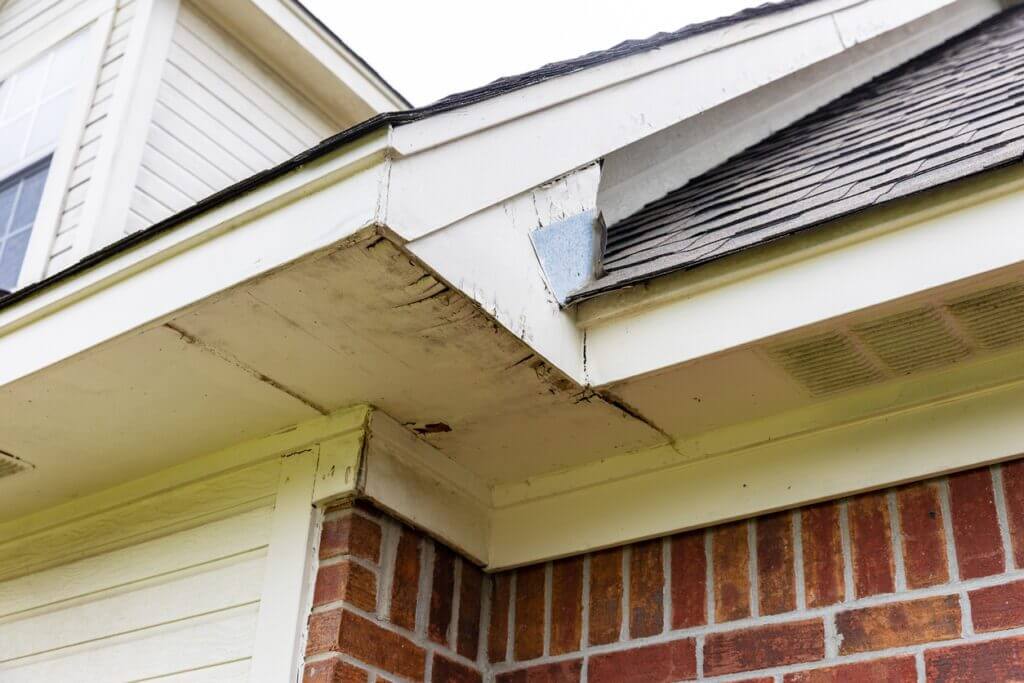
Your roofline may not demand attention every day, but when your soffit and fascia start to deteriorate, the signs are hard to ignore. Addressing issues early can save you from costly water damage, pest invasions, and even full gutter replacements.
Here are some common red flags that indicate it’s time to consider soffit and fascia repair:
1. Water Stains or Rot Along the Roofline
Discoloration, dark streaks, or soft, crumbling wood along the edge of your roof are clear indicators of moisture infiltration. Water damage often starts small—caused by clogged gutters or a leaking roof—and slowly eats away at the fascia and soffit boards.
If left untreated, rot can spread to nearby rafters and compromise the structural integrity of your roof. Getting a fascia and soffit repair service involved early can prevent more extensive and expensive repairs.
2. Sagging or Warping Gutters
Your fascia board is the mounting point for your gutter system. When the fascia begins to weaken, you might notice your gutters pulling away from the roofline or sagging in sections. This warping disrupts proper water flow and increases the risk of overflow, which can lead to foundation issues. Roof soffit and fascia repair ensures that your gutters remain securely attached and fully functional.
3. Pest Infestations (Squirrels, Birds, Bees Nesting in Attic Vents)
Damaged soffits or loose panels create easy access points for animals and insects. Birds may nest inside, squirrels might chew through weakened wood, and bees or wasps can set up hives in attic vents.
Aside from being a nuisance, these pests can cause significant damage to insulation, wiring, and wooden framing. If you’ve noticed unusual scratching sounds or droppings near the eaves, it might be time to search for soffit and fascia repair near me to have the area inspected and sealed.
4. Flaking Paint, Cracking Wood, or Detached Sections
Paint that peels prematurely or visible cracks in the fascia are not just cosmetic issues—they’re signs of weather exposure and wood deterioration. Detached soffit panels or hanging fascia sections signal that the protective barrier along your roof is failing.
A qualified soffit and fascia repair contractor near you can assess the damage and recommend repair or replacement before it spreads further.
5. Dripping Behind Gutters During Rain
If water is dripping between the gutter and the fascia instead of flowing through the downspout, the cause is usually hidden rot or misalignment. This type of leak often stems from water getting behind compromised fascia boards or from clogged soffit vents backing up moisture.
Ignoring this issue could lead to interior water damage, mold growth, and structural decay. A proper fascia and soffit repair will realign your gutter system and restore effective drainage.
Recognizing these symptoms early and addressing them with professional soffit and fascia repair services will help protect your home from long-term damage.
Common Causes of Soffit and Fascia Damage
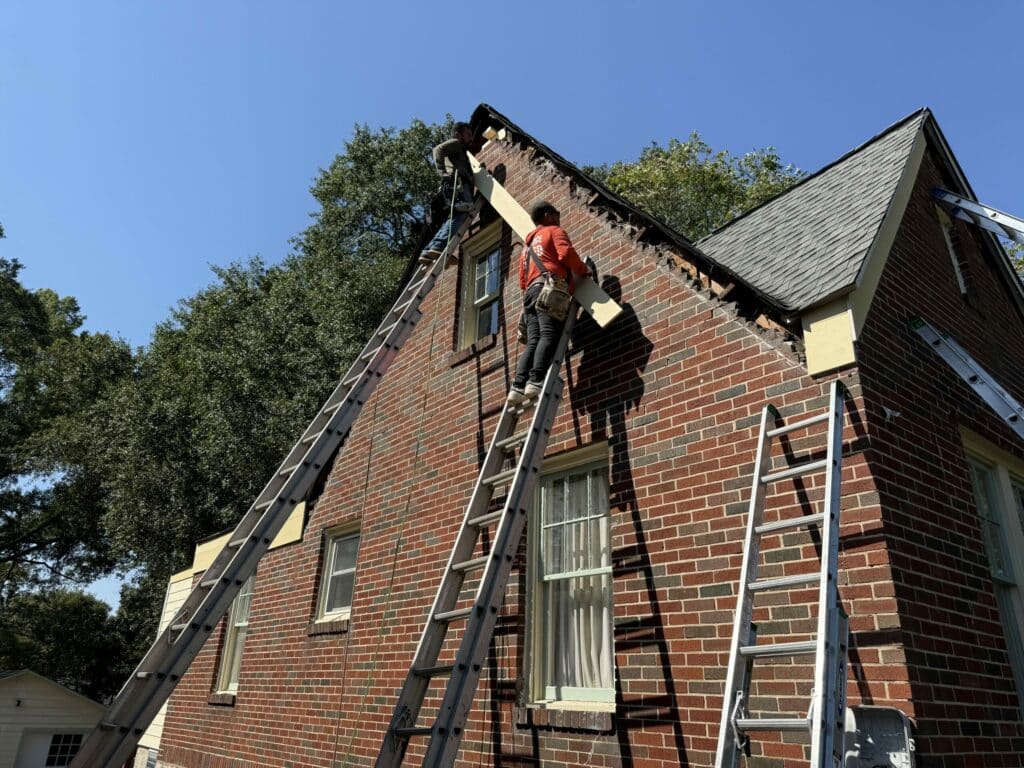
The following are common causes of soffit and fascia damage:
1. Clogged or Overflowing Gutters
When gutters become packed with leaves, pine needles, and debris, water has nowhere to go. Instead of flowing through downspouts, it spills over the sides and seeps directly into the fascia boards.
Over time, this repeated exposure causes the wood to soften, swell, and rot. Overflowing gutters can also push water up into the soffit panels, leading to moisture buildup and mold.
2. Very Common in Wooded Areas Like Roswell or Alpharetta
Homes surrounded by trees are more likely to face issues like clogged gutters and pest activity. In areas such as Roswell or Alpharetta, falling leaves, branches, and sap can contribute to blocked drainage and increased moisture retention along the roofline.
Additionally, shaded areas may not dry as quickly after rain, accelerating the deterioration of wooden soffit and fascia.
3. Improper Roof Ventilation Causing Condensation Buildup
Poor attic ventilation traps warm, moist air inside your roof, leading to condensation. This often collects near soffit vents, weakening the wood or metal panels over time. Moisture buildup without a clear exit path is a major cause of both mold growth and internal rot.
4. Aging Wood on Homes Built 40-80 Years Ago
Many older homes in Atlanta and nearby suburbs were built with solid wood fascia and soffits that, over the decades, have begun to deteriorate. Exposure to decades of heat, rain, and humidity can dry out wood, cause warping, or lead to insect damage.
In such cases, the repair might involve partial or full replacement with more durable materials. If your home is in this age range, it’s smart to get a fascia and soffit repair cost estimate before small issues turn into major projects.
5. Water Leaks From Roofline or Chimney Flashing
Roof leaks don’t just damage shingles; they also affect the edges where the soffit and fascia connect. Flashing that pulls away from the chimney or vent pipes allows water to run down into these vulnerable areas.
Even a minor leak can travel far, soaking into wood and insulation, and compromising structural components. That’s why pairing a roof inspection with a fascia and soffit repair evaluation is often recommended after storms or heavy rain.
6. Termite or Carpenter Bee Activity in Untreated Wood Fascia
Insects love untreated or unsealed wood, and the fascia board is a prime target. Termites, carpenter ants, and bees can bore into fascia to nest or feed, creating holes and weakening the structure from the inside out. This type of damage often goes unnoticed until wood starts to split or break off.
Once spotted, it’s critical to schedule professional soffit and fascia repair contractors near me who can inspect, remove infested material, and replace it with insect-resistant options.
Repair vs. Replacement: What Your Home Actually Needs
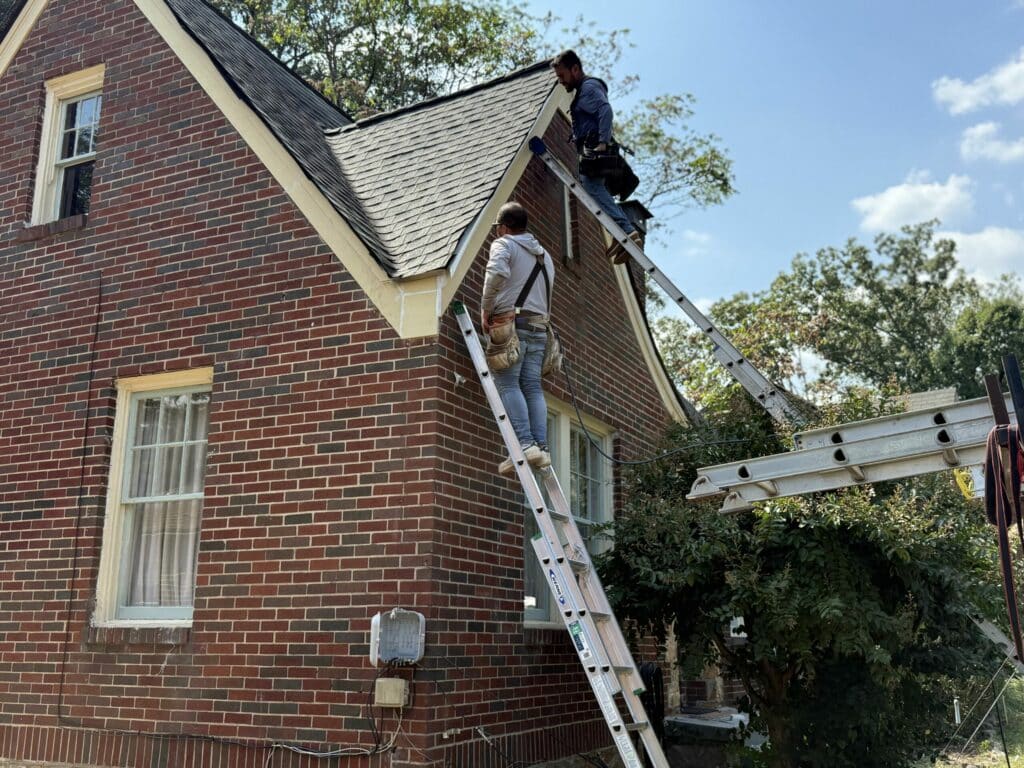
Certain types of damage are severe enough to warrant a full replacement to protect the rest of your roofing system. Knowing the difference can help you make a smart, cost-effective decision.
When You Can Repair a Section vs. When Full Replacement Is Safer
If the damage is isolated, like a small area of cracked fascia or a loose soffit panel, repairing that section can be a practical solution. This approach keeps soffit and fascia repair cost low while extending the life of the surrounding materials.
However, if the damage is widespread or hidden behind multiple sections, replacement may be the safer long-term choice.
Types of Damage That Often Require Replacement
Here are the types of damage that often require replacement:
- Severe Wood Rot: Once rot spreads, it compromises structural integrity and often impacts more than what’s visible from the surface. In this case, a full fascia and soffit repair isn’t enough; complete replacement of the affected sections is necessary.
- Mold or Pest Infestations: Mold grows quickly in moist soffit cavities, and pests like squirrels or bees often create hidden nests. If contamination is extensive, the best course is replacement with mold- or insect-resistant materials.
- Sagging Due to Structural Failure: If the fascia has detached or the soffit is bowing, the issue may involve damaged rafters or supports. Structural failures like these require more than cosmetic fixes and typically lead to full roof soffit and fascia repair.
Mr. Roofer’s Approach: Inspect and Offer Options—Not an Automatic Upsell
At Mr. Roofer, the process always starts with a thorough inspection. Instead of jumping straight to replacement, our team assesses the extent of the damage and provides clear repair vs. replacement options.
This customer-first approach ensures you only pay for what your home needs—whether it’s a minor soffit and fascia repair or a full system replacement.
Soffit and Fascia Repair Cost: What to Expect
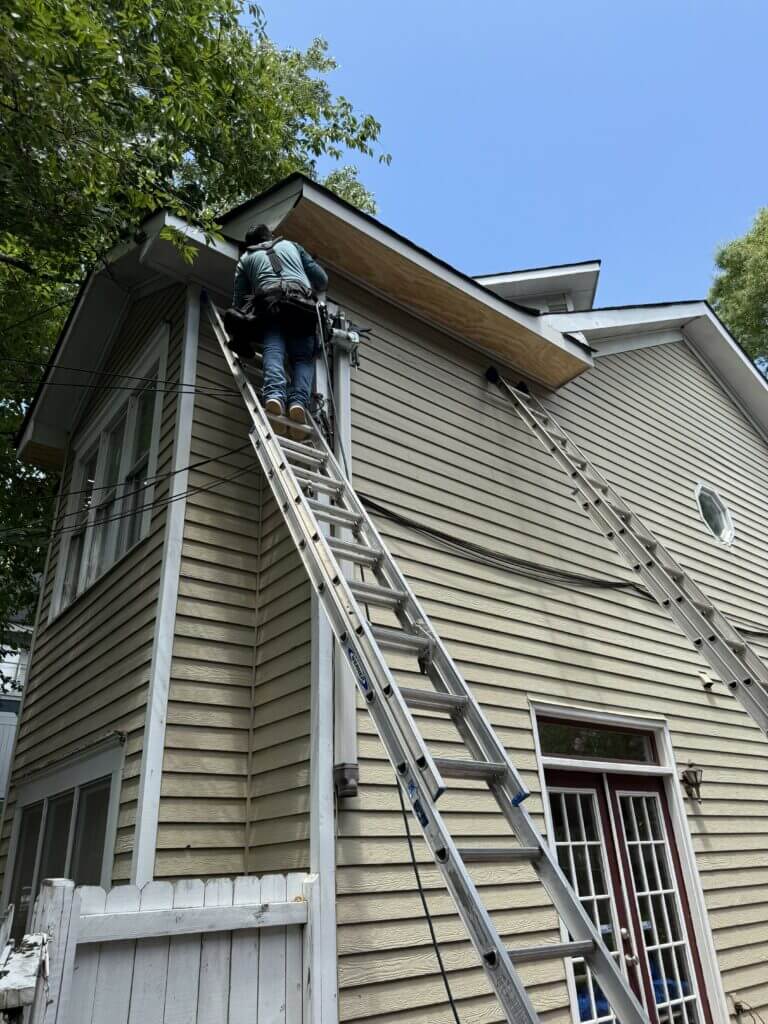
Understanding the potential costs of soffit and fascia repair helps you plan your budget and avoid surprises. In Atlanta, prices can vary widely depending on the size of your home, the extent of the damage, and the materials used.
Soffit and Fascia Repair Cost Range in Atlanta
On average, soffit and fascia repair costs in Atlanta range from $600 to $3,000. Small repairs involving a single section may be on the lower end, while full replacement or extensive restoration work will push costs higher.
The average homeowner typically spends between $15 and $40 per linear foot, depending on materials and labor.
Factors That Influence Pricing
Here are the main factors that influence the soffit and fascia repair cost:
- Material (Wood, Vinyl, Aluminum, Composite): Wood is classic but more prone to rot and insect damage. Vinyl and aluminum are more durable and cost-effective in the long run. Composite materials offer a high-end look with added resistance but come at a premium.
- Height and Accessibility: Two-story homes or steep rooflines increase labor costs due to the need for scaffolding or additional safety equipment.
- Extent of Rot or Pest Damage: Minor cosmetic fixes are cheaper, but once moisture or pests have compromised the structure, repairs become more labor-intensive and costly.
- Gutter Removal and Reinstallation: If gutters need to be removed to access the fascia and soffit, expect additional charges for removal and reattachment, especially if any sections require replacement.
Preventing Future Damage to Your Soffits and Fascia
While soffit and fascia repair services can restore your home’s protection, routine maintenance goes a long way in preventing future issues.
- Annual Gutter Cleaning and Inspection: Clogged gutters are a leading cause of water damage along the fascia. Clean them at least once a year, twice in wooded areas like Roswell or Alpharetta.
- Proper Attic Ventilation and Moisture Control: Ensure soffit vents are clear and attic humidity stays low to prevent mold and rot.
- Painting or Sealing Wood Surfaces Every 3-5 Years: Treated wood resists moisture and insect damage far better than untreated or faded finishes. Regular sealing extends the life of your fascia and soffit.
- Keeping Tree Limbs Trimmed Away From the Roofline: Overhanging branches can clog gutters, scrape surfaces, and provide access for pests. Trimming trees also reduces leaf buildup and prevents impact damage during storms.
Staying proactive with these measures reduces the risk of needing emergency repair for soffit and fascia and protects your investment for years to come.
Protect Your Roofline with Expert Soffit and Fascia Repair in Atlanta
Your soffits and fascia may not always be in plain sight, but they play a critical role in preserving the structure, ventilation, and overall health of your home. Whether you’re dealing with peeling paint, sagging gutters, or signs of rot, timely soffit and fascia repair can prevent more serious—and expensive—roof damage down the road.
If you’re unsure whether you need a simple repair or a full replacement, trust the professionals at Mr. Roofer of Atlanta. Our experienced team will thoroughly inspect your roofline, explain your options clearly, and recommend the most practical solution, without pushing unnecessary upsells. We serve Atlanta and surrounding areas, including Roswell, Alpharetta, and beyond.
Contact Mr. Roofer today for a personalized quote or to schedule an inspection. Protect your home from the top down with reliable, honest, and professional soffit and fascia repair services.
